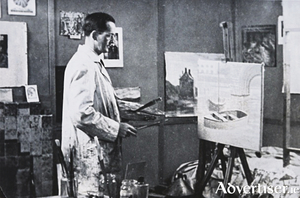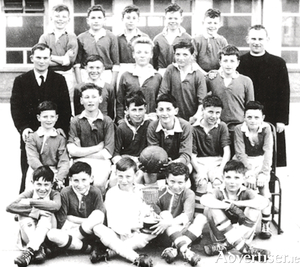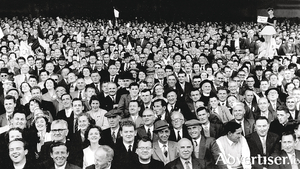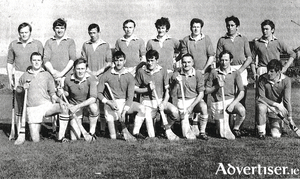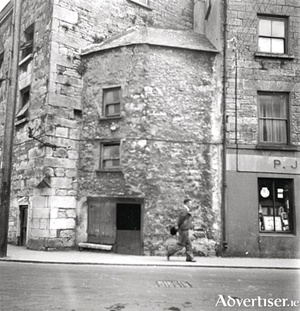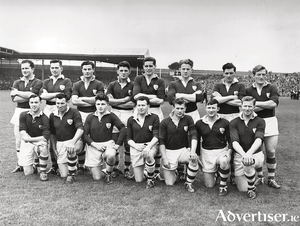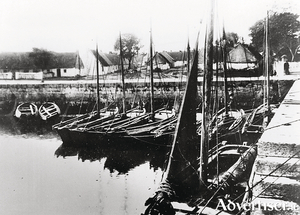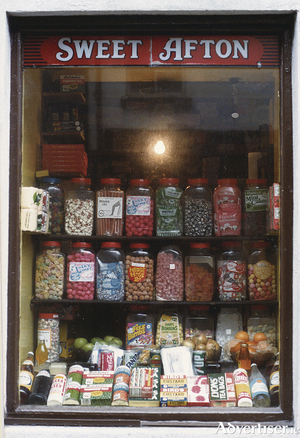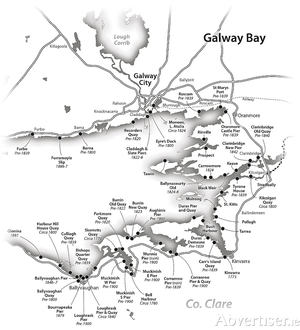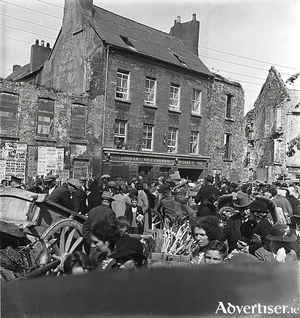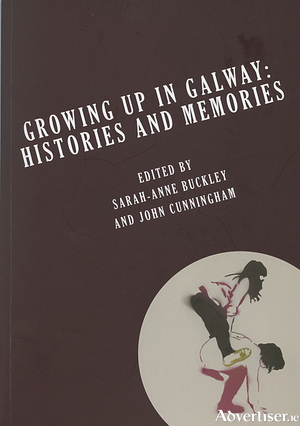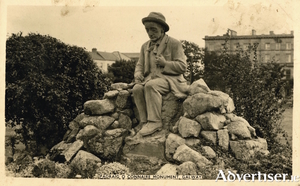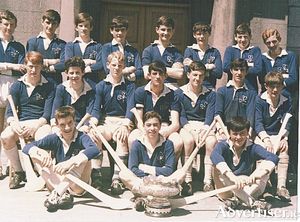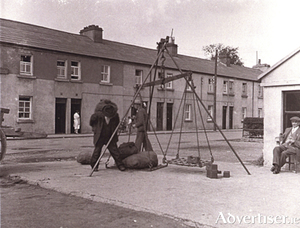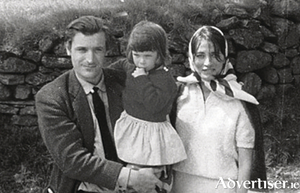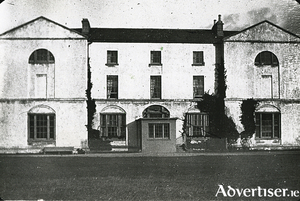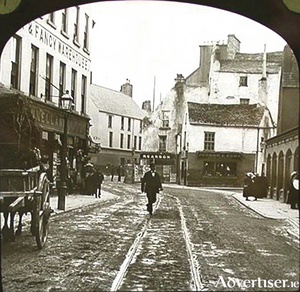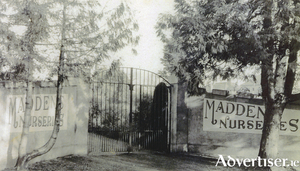Francis Corbett in his studio
Thu, Jan 25, 2018
Francis Corbett was a member of the well known business family who owned Corbett and Sons in Williamsgate Street. He was one of five siblings, one of whom, Gerard, went into the business. Francis also worked there but only for a short time, as he died relatively young in 1946. He was a talented artist, as were his brother Redmond and his sisters Lucy and Agnes. Francis was one of the founders of the Galway Art Club, and became its first treasurer.
Read more ...Fr Lally’s Street League under 14 champions, 1965
Thu, Jan 18, 2018
In 1881, Father Lally was made parish priest of Rahoon. At the time the parish was served by two churches, Bushypark and Barna, Dr McEvilly, Bishop of Galway was appointed as Archbishop of Tuam, and Father Lally was made Vicar Capitular of the Diocese in the interregnum until the appointment of a successor to Dr McEvilly. Dr McEvilly was aware that the very large parish of Rahoon had no central church so he gave Fr Lally money to start the process of erecting a new church beside the Presentation Convent. Fr Lally collected the funds and employed direct labour to build the church. The foundation stone of St Joseph’s was laid on April 22, 1882, and the church was consecrated on February 7, 1886.
Read more ...Will Galway beat Mayo?
Thu, Jan 11, 2018
The rivalry between Galway and Mayo is as old as the provincial championship itself. The Connacht GAA Council was actually founded on the same day that Galway and Mayo contested the first ‘official’ Connacht senior football final. That game was played in Claremorris in November 1902 and was won by Mayo. Galway played “with the wind and the incline” in the first half while the vast crowd agreed to “keep strictly outside the field of play”, something the organisers clearly regarded as an unexpected bonus.
Read more ...Liam Mellows, county champions
Thu, Jan 04, 2018
We know that hurling was played in the Bohermore area 200 years ago. Several different clubs operated around there at different times — Galway City, Bohermore 98s, College Road, Thomas Ashe, etc. Players would occasionally transfer from one club to another so it was natural for them to join the new club that was formed on February 11, 1933. The club was called Liam Mellows after the patriot who led the 1916 rebellion in Galway.
Read more ...The nailer forge
Thu, Dec 28, 2017
The Connaught Journal of July 1823 reported that Michael Walsh, the nailer of Bridge Street, was in great distress. He was described as being very poor, and though he worked hard, his life had been a struggle for some 12 years now because of a ‘disease of his leg’. The unfortunate man had to have the leg amputated and was now ‘reduced to extreme want’ as he was unable to work. The newspaper highlighted his predicament and hoped that the charitable and humane people of Galway would contribute to his support while he was recovering from the operation. So we know that the nailer was in business there some 200 years ago.
Read more ...Remembering Tom McHugh
Thu, Dec 21, 2017
This is the Galway football team that played Tyrone in the 1956 All-Ireland semifinal in Croke Park. They are, back row, left to right: Seán Purcell, Gerry Kirwan, Joe Young, Jack Kissane, Frank Evers, Mattie McDonagh, Tom McHugh, and Billy O’Neill. In front are Mick Greally, Tom ‘Pook’ Dillon, Sean Keely, Jack Mangan, Frank Stockwell, Jack Mahon, and Gerry Daly. The first score in the game was a brilliant point by Galway’s Tom McHugh. Galway won a thrilling close game that featured a high degree of sportsmanship, and went on to beat Cork in the final.
Read more ...The sinking of the Neptune
Thu, Dec 14, 2017
This photograph was taken about 100 years ago and shows several boats from the Claddagh fleet moored at the quayside.
Read more ...The sweets of our childhood
Thu, Dec 07, 2017
A sweet is defined as having a taste of sugar or honey. It is not bitter or sour, but is pleasingly fragrant and agreeable. It is strange that while the taste never lingers too long, the memory of that taste can stay with you for life, particularly if it was one of the favourite sweets of your childhood. The sweet shops of yesteryear had a special smell, an aroma of temptation which you got as you went through the door. Even to look in the shop window was to make an imaginative journey of the various tastes that were on display. Our photograph today, which was taken about 40 years ago by Marja Van Kampen, will tick memory boxes for many people. The mouthwatering display was in Miko Cunningham’s shop window in Upper Abbeygate Street.
Read more ...Humble Works for Humble People
Thu, Nov 30, 2017
Our illustration today is of the inner part of Galway Bay and shows the piers and harbours therein. It is one of the images in a new book entitled Humble Works for Humble People written by Noel Wilkins, a retired professor of zoology who has a number of titles to his name already, many of them dealing with County Galway. This book explores the history of the fishery piers and harbours of County Galway and north Clare. It is a scholarly but eminently readable testament to these piers as feats of engineering, but it also gives us a wonderful account of the human aspect that shadowed their construction, and finally it describes beautifully the maritime activities that gave life to the west coast — kelp making, fishing, turf distribution, and sea-borne trade.
Read more ...A Galway tradition
Thu, Nov 23, 2017
In Hely Dutton’s Survey of Galway in 1824, he reported; “The vegetable market near the Main Guard is generally well supplied, and at reasonable rates; all kinds come to the market washed, by which any imperfection is easily detected. The cabbage raised near the sea on seaweed is particularly delicious; those who have been used to those cultivated on ground highly manured cannot form any idea of the difference. There are also, in season, peaches, strawberries, gooseberries, apples, pears etc.”
Read more ...Cherishing all the children equally?
Thu, Nov 23, 2017
Back in the 1960s my late mother had a two-door Morris Mini-Minor. The mini, about the size of a dog-kennel on wheels, was our family car for years (dad drove a van used for deliveries). I think the mini won the Monte Carlo Rally at one time and it became famous. Towards the end of the decade it actually became cool to have a Mini-Minor after the film The Italian Job, starring Michael Caine. But my brother and I had long legs, and the car became a torture chamber on long journeys. We hated the car. There was little room for us and later for my sister, and all her stuff, the dog (who went ballistic if he saw another dog on the street), the weekly shopping, and all the detritus that family cars gather.
Read more ...Pádraic Ó Conaire: man and monument
Thu, Nov 16, 2017
On October 6 1928, writer, journalist, teacher, and raconteur Pádraic Ó Conaire died in tragic poverty in Richmond Hospital, Dublin, at the age of 46. Since the turn of the century he had established himself as one of the leading lights of the Gaelic Revival, an innovative writer who pioneered the short story in Irish.
Read more ...Under 16 Bish
Thu, Nov 16, 2017
This was the team representing St Joseph’s College which won the Rosebowl Cup in 1968.
Read more ...The crane at Woodquay
Thu, Nov 09, 2017
In the early 19th century, most of the area we see in our photograph would have been under water. Woodquay was so called because of the 150 feet wooden quay that ran the length of it. It was a kind of second docks for the city, attracting a lot of commercial traffic down the river. The Corrib Drainage Scheme in 1852 began to change the face of the space we are looking at, and later, when Steamer’s Quay was built, the area was gradually filled in and reclaimed.
Read more ...Letter from Ted Hughes to his brother Gerald, April 1966.
Thu, Nov 09, 2017
Week II
This place is a mild paradise for me at present. We moved yesterday, from our sumptuous home, to a much older, wilder place - £2 a week, a house annexed to a big farm (big for this region) at the top of Cleggan bay - right on the west coast. I have a ramshackle roomful of silence to work in. I look out at a heathery hillside, and if I stand I see the open Atlantic. The village is about 1 mile away. It’s a blue, still day. I’ve worked fairly steadily for 6 weeks and now I’m going quit smoothly, and plenty of improvement still in hand. The kids are brimming over. Assia is here with me and a complete success. We have a good local girl, Teresa, helping us...
Galway Grammar School, 1903
Thu, Nov 02, 2017
Galway Grammar School was a Protestant institution established under the Erasmus Smith Trust in 1669. It opened around 1675 and has been located at College Road since 1815. The 1950/51 school year was an eventful one when, in November of that year, a wing of the school was gutted by fire, happily, there was no danger of loss of life. Four months later a dormitory ceiling collapsed. The headmaster, George Coughlan, said that the collapse was caused by a 24 foot beam being charred through by a chimney fire. The beam brought down two other beams and half the ceiling. In many old buildings, beams went into chimney flues and successive chimney fires charred them until they came down. Neither incident occasioned an interruption in the school routine.
Read more ...Looking west on Shop Street, c120 years ago
Thu, Oct 26, 2017
The first thing you notice about this image is the state of the street surface with its animal droppings and puddles. You had to be careful crossing the street, which is why they laid down cobbles between footpaths, you can see them at the entrance to Church Lane and Churchyard Street.
Read more ...Galway folklore
Thu, Oct 19, 2017
More than 300 primary school teachers attended a conference in Tuam in 1937, 80 years ago tomorrow, to launch the Schools Folklore Collection in Galway County. This was a scheme which invited senior primary pupils, under direction, to go to the oldest person in their community or their grandparents to collect folklore and folk life traditions relating to their own area. Caitríona Hastings has just published a book in which she has selected material from this project which was gathered by pupils of 14 schools in Galway and environs. They are Menlo NS, Castlegar NS, Carrowbrowne NS, Barna, Bushypark, Presentation Convent, Convent of Mercy NS, Claddagh NS (boys), Claddagh (girls), St Brendan’s NS, Claregalway (boys), Claregalway (girls), Oranmore (boys), and Oranmore Convent.
The result is a wonderful collection of prose and poems, in English and Irish, written in simple child-like language, covering subjects such as children’s games, leprechauns, ghosts, hidden pots of gold, prayers, proverbs, riddles, cures, the fairies, superstitions, place names, holy wells, traditional food, churning, rush candles, weather lore, the care of the feet. This last item was particularly important as most children went barefoot for at least half of the year.
Read more ...Madden’s Nurseries
Thu, Oct 12, 2017
Michael Madden came to Taylor’s Hill from the Ballinasloe area c1898. His family had been in the nursery business there since the 1830s, and in Laurencetown before that again. He leased the land in Taylor’s Hill from Colonel Courtney. In 1902, his brother James and his wife Elizabeth came to live there also, and a few years later, on Michael’s death, they took over the running of the nurseries.
Read more ...‘Oh steer my bark to Erin’s Isle...’
Thu, Oct 12, 2017
On Friday evening towards the end of the Easter Rising, there was one further horrific incident that convined Padraic Pearse that surrender, and quickly, was the only course open to the rebels.
There was a chaotic retreat from the burning GPO, with surrounding streets ablaze, and British soldiers firing from barricades. The streets around the centre of Dublin were death traps. Yet even while artillery shells ripped through buildings, and exploded into shards of metal, a group of men and two women, some carrying a wounded man on a stretcher, ran towards Moore Street, which was out of the immediate battle zone.
Read more ...